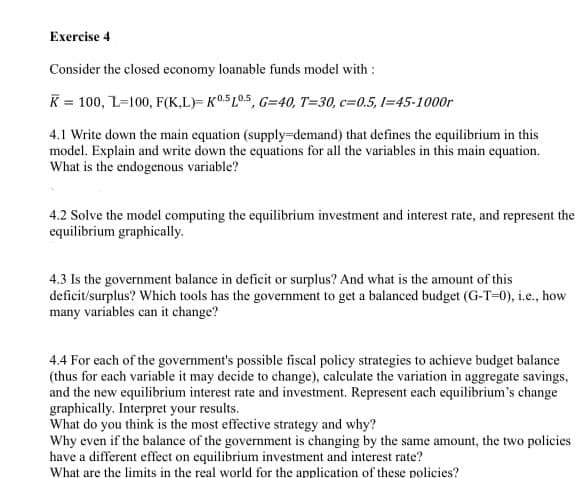Exercise 4 Consider the closed economy loanable funds model with : K = 100, L-100, F(K,L)= K®.5L05, G=40, T=30, c=0.5, 1=45-1000r 4.1 Write down the main equation (supply-demand) that defines the equilibrium in this model. Explain and write down the equations for all the variables in this main equation. What is the endogenous variable? 4.2 Solve the model computing the equilibrium investment and interest rate, and represent t equilibrium graphically. 4.3 Is the government balance in deficit or surplus? And what is the amount of this deficit/surplus? Which tools has the government to get a balanced budget (G-T-0), i.e., how many variables can it change?
Exercise 4 Consider the closed economy loanable funds model with : K = 100, L-100, F(K,L)= K®.5L05, G=40, T=30, c=0.5, 1=45-1000r 4.1 Write down the main equation (supply-demand) that defines the equilibrium in this model. Explain and write down the equations for all the variables in this main equation. What is the endogenous variable? 4.2 Solve the model computing the equilibrium investment and interest rate, and represent t equilibrium graphically. 4.3 Is the government balance in deficit or surplus? And what is the amount of this deficit/surplus? Which tools has the government to get a balanced budget (G-T-0), i.e., how many variables can it change?
Chapter1: Making Economics Decisions
Section: Chapter Questions
Problem 1QTC
Related questions
Question
4.3 and 4.4 solution needed urgently

Transcribed Image Text:Exercise 4
Consider the closed economy loanable funds model with :
K = 100, L=100, F(K,L)= K05L05, G=40, T=30, c=0.5, 1=45-1000r
4.1 Write down the main equation (supply-demand) that defines the equilibrium in this
model. Explain and write down the equations for all the variables in this main equation.
What is the endogenous variable?
4.2 Solve the model computing the equilibrium investment and interest rate, and represent the
equilibrium graphically.
4.3 Is the government balance in deficit or surplus? And what is the amount of this
deficit/surplus? Which tools has the government to get a balanced budget (G-T-0), i.e., how
many variables can it change?
4.4 For each of the government's possible fiscal policy strategies to achieve budget balance
(thus for each variable it may decide to change), calculate the variation in aggregate savings,
and the new equilibrium interest rate and investment. Represent each equilibrium's change
graphically. Interpret your results.
What do you think is the most effective strategy and why?
Why even if the balance of the government is changing by the same amount, the two policies
have a different effect on equilibrium investment and interest rate?
What are the limits in the real world for the application of these policies?
Expert Solution
This question has been solved!
Explore an expertly crafted, step-by-step solution for a thorough understanding of key concepts.
This is a popular solution!
Trending now
This is a popular solution!
Step by step
Solved in 2 steps

Recommended textbooks for you


Principles of Economics (12th Edition)
Economics
ISBN:
9780134078779
Author:
Karl E. Case, Ray C. Fair, Sharon E. Oster
Publisher:
PEARSON

Engineering Economy (17th Edition)
Economics
ISBN:
9780134870069
Author:
William G. Sullivan, Elin M. Wicks, C. Patrick Koelling
Publisher:
PEARSON


Principles of Economics (12th Edition)
Economics
ISBN:
9780134078779
Author:
Karl E. Case, Ray C. Fair, Sharon E. Oster
Publisher:
PEARSON

Engineering Economy (17th Edition)
Economics
ISBN:
9780134870069
Author:
William G. Sullivan, Elin M. Wicks, C. Patrick Koelling
Publisher:
PEARSON

Principles of Economics (MindTap Course List)
Economics
ISBN:
9781305585126
Author:
N. Gregory Mankiw
Publisher:
Cengage Learning

Managerial Economics: A Problem Solving Approach
Economics
ISBN:
9781337106665
Author:
Luke M. Froeb, Brian T. McCann, Michael R. Ward, Mike Shor
Publisher:
Cengage Learning

Managerial Economics & Business Strategy (Mcgraw-…
Economics
ISBN:
9781259290619
Author:
Michael Baye, Jeff Prince
Publisher:
McGraw-Hill Education